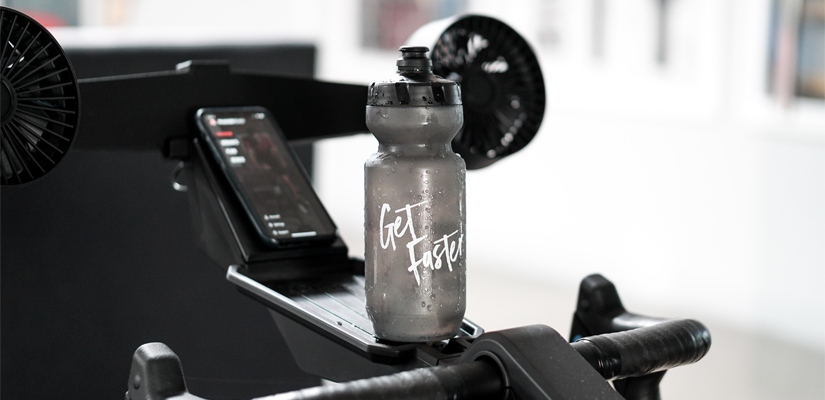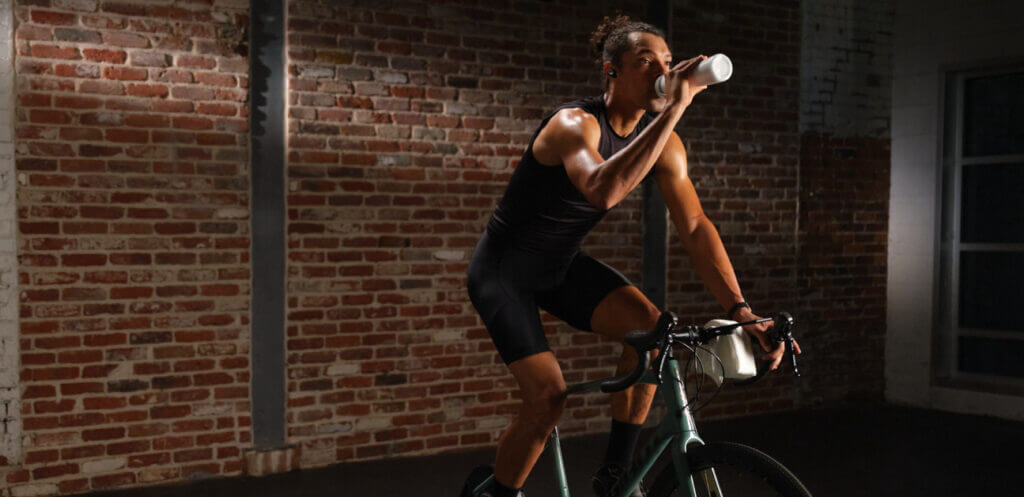How to Hydrate For Indoor Cycling Workouts

Depending on your sweat rate and sweat composition, you might need extra water and electrolytes for your indoor workouts. Planning hydration around your sweat rate and using a fan to assist your body’s evaporative cooling process can improve your indoor workouts.
For more information on sweat and hydration check out Ask a Cycling Coach Ep 260.
Find links to mentioned studies and join the discussion on the TrainerRoad Forum: here.
Why Athletes Sweat
Sweat is an integral part of your body’s self-cooling process. When you exercise, your core body temperature rises. Your body releases sweat from the pores of your skin in response to the rise in body temperature. The sweat on the surface area of your skin then evaporates from your skin, which helps your body cool off. This process of cooling is called evaporative cooling.
Why Athletes Sweat More Indoors
The average cyclist tends to sweat more when training indoors. This is because there’s usually less airflow when you ride inside. When there’s limited airflow, and you’re in a smaller space, the room can become increasingly humid as you sweat. This makes it progressively harder for the sweat to evaporate from your skin. In turn your core body temperature can continue to rise, or stay elevated, and your body will continue to sweat.
Because we generally sweat more when training indoors, drinking enough water and consuming sufficient electrolytes, before, during, and after indoor workouts is crucial. Staying hydrated during your indoor workouts impacts your physical performance and helps your body continue to manage its temperature.
The Basics of Sweat
While everyone sweats, not everyone’s sweat is the same. How quickly you sweat and how much salt you lose in your sweat is unique to your physiology. The amount of water and electrolytes you should be taking in during an indoor workout can vary based on your sweat rate and sweat composition.
Sweat Rate
Sweat rate is the rate at which your body releases sweat. It can be thought of as the amount of liters per hour your body sweats. Everyone has a different sweat rate. Depending on your body weight, the density of your sweat glands, and your capacity to sweat, your sweat rate might be higher or lower than the average person. A higher sweat rate might mean you need to take in more water while a lower sweat rate could demand less water.
While your sweat rate is an independent part of your physiology, how much you sweat can vary from one workout to the next. You’ll probably sweat more during a hot indoor workout then you would during a cool outdoor recovery ride.
Sweat Composition
Sweat composition, on the other hand, is mostly stable from one workout to the next. Sweat composition is the concentration of sodium in your sweat. Whether you’re training hard on a hot day or doing a recovery spin on a cool one, the level of sodium in your sweat is relatively similar from workout to workout. Research suggests that consuming a lot of sodium, or too little sodium can impact the amount of sodium in your sweat, but this variable generally remains the same.
Adaptive Training
Get the right workout, every time with training that adapts to you.
Check Out TrainerRoadKnowing Your Sweat
Depending on your sweat rate and sweat composition, how much electrolytes you should consume during an indoor workout may vary. If you’re a heavy sweater, you might need to drink more water in a given session. If you lose a lot of salt when you train, you might need to take in more electrolytes during your workouts. Athletes can begin with general hydration rules, but will also want to drink intuitively and pay attention to their own unique response to different hydration strategies. Best practices will vary based on the athlete.
Hydration for Hour Long Workouts
If you have an indoor workout that is less than an hour, what you drink on the bike isn’t going to have a significant impact on your hydration during that workout. In fact, your level of hydration and electrolytes going into that workout will be more important for that hour then what you drink during the workout. If your workouts are less than an hour be conscious of your hydration and electrolytes going into the workout.
With that said, it’s still a good idea to bring a bottle of water onto the trainer for hour-long workouts. Even if it’s not crucial for that particular workout, drinking while you ride reinforces good hydration habits. The habits you build on the trainer are the habits you take into races and demanding days on the bike. Drinking a full bottle during an hour-long workout is a great way to reinforce good habits.
Hydration for Longer Workouts
When the duration of your workout is longer than an hour, what you drink on the bike becomes more important. If you’re planning on riding more than an hour, it’s a good idea to be taking in fuel, water, and electrolytes within the first hour. Especially if you are a heavy sweater.
The general rule is to drink proactively and take in a bottle an hour. Once you pass the hour mark, you may want to take in electrolytes as well. The longer the workout, the more critical it is to take in electrolytes on the bike. If you train longer than two hours you may also want to consider taking in a drink with electrolytes after your workout to aid the recovery process and replenish lost electrolytes.
With that said, because sweat rate and sweat composition are unique to your physiology, exactly how much water and electrolytes you should be taking per hour of exercise can vary. For a lot of athletes, a bottle an hour is perfect. Overall, athletes should hydrate and fuel intuitively and pay close attention to their body’s response to changes in hydration.
Use a Fan!
One of the biggest mistakes we see is that athletes forget about cooling their indoor workouts. Fans have a significant impact on hydration. While they aren’t directly correlated to hydration, they do play a major role in your body’s ability to cool off. Fans create airflow and aid the evaporative cooling process. You want to use a fan that moves a lot of air. We like this one.
For more cycling training knowledge, listen to Ask a Cycling Coach — the only podcast dedicated to making you a faster cyclist. New episodes are released weekly.
